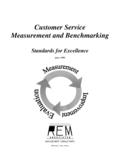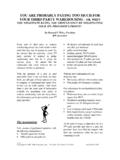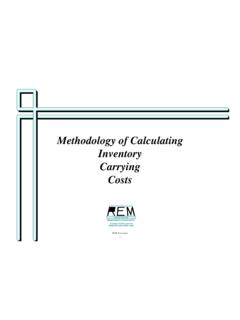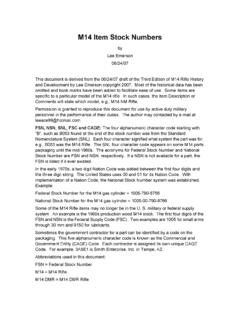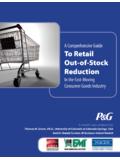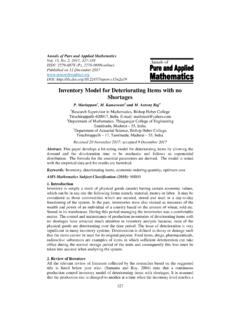Transcription of Inventory Cycle Counting - REM Associates
1 Inventory Cycle Counting 20 Nassau Street, Suite 244. Princeton, NJ 08543-7345. Phone: (609) 275-4444. Fax: (609) 275-5651. Email: WWW: Cycle Counting TABLE OF CONTENTS. Cost of Inaccurate Records .. 4. Two approaches: Periodic and Cycle .. 4. ABC Inventory Analysis .. 5. ABC 5. Extension of The ABC Analysis .. 6. Count Frequency .. 7. Implementing a Cycle Count Process .. 7. When To Count .. 8. Causes of Inventory Accuracy Errors .. 8. Summary .. 8. Copyright @1999, REM Associates of Princeton, All rights reserved 2. Cycle Counting Introduction Inventory accuracy is a critical and highly sensitive area affecting firms. Cycle Counting can increase Inventory accuracy to levels of 97% and better, while offering significant cost savings when compared to physical Inventory Counting that the majority of firms currently use. Inventory record accuracy has a significant impact on increasing levels of customer service, reducing costs, and increasing productivity.
2 Safety stock is typically held due to inaccurate records because procurement does not trust the Inventory record accuracy. When Inventory is located correctly and warehouse pickers do not have to search for items, productivity is increased. Customer service increases due to more accurate stock information, less backordering, and fewer stock-outs. The physical Inventory process is one of the most widely used and commonly accepted practices to account for Inventory . This process does have some drawbacks: 1. The process is unautomated and is prone to errors due to the amount of paperwork involved 2. Operations typically must be shut down for a physical Inventory 3. Personnel used to take a physical count are often not trained and are unaware of stock locations, increasing room for errors in the count. 4. Temporary help (and overtime help) sometimes must be hired in order to get the physical Inventory count completed within a specific time frame.
3 Cycle Counting is the process of Counting Inventory items throughout the year on a schedule so that all items are counted at least once a year. The primary focus is on items that move more frequently, with less attention given to items that move less frequently. This process is much more efficient than a physical Inventory , utilizes employees that are familiar with Inventory and warehouse locations, and can uncover processes that produce Inventory inaccuracies. Cycle counters perform counts of SKU's (Stock Keeping Units) and record the information. This count is then checked, based on the actual record, to see if there is a discrepancy between the two counts. A tolerance level is used to see how much above or below the actual count is when compared to the record count. This tolerance level is low for fast-moving items and higher for slower moving items.
4 When a count is taken that is outside of the tolerance level, an examination is undertaken to understand the root cause of the error so that the source of the error can be eliminated. This process has an impact on Inventory records for all items through repairing the process that accounted for the inaccurate information. Under the physical Inventory process, this type of investigation is impossible, and process errors are never repaired. There are numerous tools available that companies can use to automate Cycle counts and increase Inventory accuracy to optimum levels. Copyright @1999, REM Associates of Princeton, All rights reserved 3. Cycle Counting Cost of Inaccurate Records There are built-in inefficiencies and hidden costs directly and indirectly related to inaccurate Inventory records. Excess Inventory Levels: When Inventory records are inaccurate, additional purchases will oversupply the warehouse resulting in excess Inventory and a lower annual turnover rate.
5 This excess Inventory increases annual carrying cost and increases the chance for product obsolescence. Lower Productivity Levels: Warehouse productivity levels can be decreased substantially when pickers have to search for products instead of getting them from prime pick locations. When records are inaccurate, shortages occur. Therefore, Inventory is not where warehouse-tracking systems think it should be. Expediting Orders: When Inventory records are not accurate, product transit needs to be expedited so that sales are not missed. This process takes a considerable amount of time of purchasers, receivers, and supervisors to update records, order the product, and receive the product. These types of orders are also very expensive on both ends of the supply chain based on time and excess freight costs from expediting smaller orders.
6 Lost Sales: When Inventory records are inaccurate, the promised stock for customers may not be available at all, or shortages in orders may occur. These customers will either have to wait for an order to come in or get the product from a competitor, resulting in lost sales and potential loss of accounts. Two approaches: Periodic and Cycle There are two approaches to maintaining Inventory records: periodic physical Inventory and Cycle Counting . Periodic Physical Inventory : This is typically referred to as the annual physical Inventory method. This approach is the Counting of all SKU's within a short time frame and is typically done once a year. It usually requires a large number of employees and cannot be done while the business is operating. Some problems with this approach are: 1. Inefficient use of employees; temporary help is usually required.
7 2. Errors cannot be tracked and fixed because of time constraints. Copyright @1999, REM Associates of Princeton, All rights reserved 4. Cycle Counting 3. The operation typically must be shutdown for a physical Inventory to be taken. 4. There is little, if any, increase in record accuracy. Cycle Counting : The Cycle Counting approach is a techniques that segments Inventory based on an ABC analysis and sets up a time schedule for when items should be counted throughout the year so that when the time frame of one year passes, all SKU's have been counted at least one time, with the faster moving SKU's being counted multiple times per year. This program uses people who are familiar with the warehouse, locations of SKU's, and the activities surrounded by Inventory management. It is also these employees' responsibility to define inconsistencies in Inventory records and trouble shoot the processes causing the errors.
8 Cycle Counting has the following benefits: 1. Few mistakes in item identification. 2. The ability to identify and correct record errors. 3. The operation does not have to be shutdown during a Cycle count. 4. Fewer, more experienced people are used to perform a Cycle count. 5. There is a systematic improvement in the processes that dictate inaccurate records. In order for a Cycle Counting process to be implemented, the first action to be taken is to assign a count frequency based on an Inventory ABC analysis. ABC Inventory Analysis ABC analysis is a method of assigning and classifying SKU's. For the Cycle Counting procedure, SKU's are ranked from highest to lowest based on the annual sales volume at cost. The idea behind this ranking is based on the 80/20 rule, where 80% of the volume in the warehouse comes from only 20% of the SKU's.
9 Table B is an example of an ABC analysis. "A" items account for the top 80% of sales, while "B" items account for the next 15% of sales, and "C" items account for the last 5% of sales. Typically, more that half of the items are "C" items. Understanding this analysis shows that 80% of sales or volume comes from a very small percentage of items. ABC Calculations Putting together an ABC analysis is really quite simple as long as the data is in a format that can be manipulated on a computer. The requirements are SKU Numbers, Units On Hand, Unit Sales for a 12-Month Period, and Last Cost per Unit. As long as this data is available, Inventory on hand and annual sales can be calculated. Follow these steps: 1. Calculate annual usage, in dollars, for each SKU. 2. Rank (sort) the SKUs' descending order based on annual dollar usage Copyright @1999, REM Associates of Princeton, All rights reserved 5.
10 Cycle Counting 3. Assign ABC classifications based on the criteria described above The following table is an example of an ABC ranking and classification: Cummulativ Percent Cummulative Item SKU Last Unit Quantity Inventory Annual Annual Sales e Percent of of Total Percent of Total ABC. Number Number Cost On Hand Dollars Unit Sales Dollars Items Sales Sales 1 10950200 $ 5,500 $ 297,825 61,040 $3,305, A. 2 10637000 $ 10,635 $ 143,573 130,060 $1,755, A. 3 10217000 $ 4,563 $ 75,746 98,322 $1,632, A. 4 10110200 $ 2,499 $ 112,455 31,990 $1,439, A. 5 11093000 $ 7,128 $ 133,930 57,022 $1,071, B. 6 10481000 $ 85 $ 76,296 1,008 $904, B. 7 10157000 $ 256 $ 52,659 2,450 $503, B. 8 11069000 $ 1,078 $ 11,341 14,140 $148, B. 9 10061000 $ 5,016 $ 11,587 46,242 $106, C. 10 10421000 $ 510 $ 34,578 1,134 $76, C. 11 10661000 $ 365 $ 9,746 2,870 $76, C.
